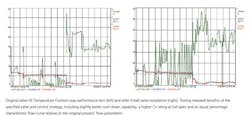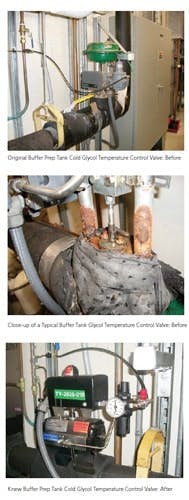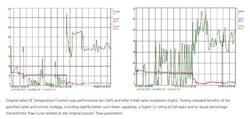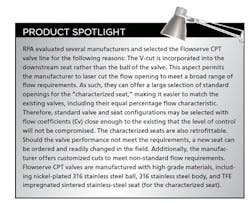A biopharmaceutical plant in the United States was operating a cold/chilled glycol (CG) system to cool approximately 50 process vessels, mainly jacketed tanks (250 – 3500 L), and several heat exchangers to produce its products. The plant was approximately 18 years old and circulated propylene glycol (40%) and water (60%) as the heat transfer medium. Chillers in the basement generated 28 F (-2 C) cold glycol, which was then circulated by three constant-speed centrifugal pumps to the distribution network. System differential pressure control was achieved with a bypass valve that short-circuited the CG supply to the return side during periods of low demand.
Globe-style control valves, located in the mechanical rooms, provided temperature control of the process vessels. The valves were automated (PID control) through the plant’s distributed control system (DCS).
However, being 18 years old, the original valves were providing inadequate positive shut-off as required for their application. Specifically, the plant experienced a temperature excursion in one of the tanks, because cooling fluid passed through a closed control valve, resulting in over-cooling of the tank and product. In addition, many of the valves were leaking externally through their (re-built) packing, causing accelerated corrosion of the carbon steel valves. Obsolete and non-maintainable, the original valves had become a real liability.
Selection Criteria
The biopharmaceutical company in question hired RPA Engineering to evaluate the existing process conditions and provide a solution for the passing control valves. The criteria was to maintain the existing temperature control scheme, provide tight shutoff (Class VI or better), and match the existing flow capability (flow coefficient, Cv), all with a standard platform and manufacturer that would be fully supported for the foreseeable future (10-20 years).
This flow control strategy is well suited to short-term batch type operations with discrete start/stop of the temperature control function.
However, the plant required tank temperature control for extended and unidentified periods of time (up to 30 days), during which the valves would continuously cycle through closed and partially open positions. Inefficient and cumbersome, this solution required additional programming and associated change control documentation — a task that generates considerable time and expense. RPA system designers opted for a less complex and, therefore, less costly solution.
Because the original globe valves were outdated and were in a supporting utility system — as opposed to being directly involved a product processing train — it was feasible to replace them with functionally “like-for-like” valves in lieu of an exact match. For this application, RPA engineers evaluated the functionality of ball valves with a “V” cut, otherwise known as V-ball valves. Capable of both modulating control and positive shut-off, V-ball style control valves met the functionality requirements that would be provided by any “like-for-like” replacements of the failing, end-of-service-life control valves.
Pilot Study
First, a pilot study on one of the process jacketed tanks was performed with the new V-Ball valve (see photos) to prove the concept. The starting point for the selection of the new valve was to accept that the existing control capability was adequate with, of course, the exception of positive shut-off. The new valve also needed to maintain the existing performance level without requiring re-tuning of the PID constants already programmed in the DCS.
In order to specify the new valves, RPA performed a walkdown of the existing valve to verify the installed piping configuration and obtain nameplate data. In addition, the original design calculations were reviewed in conjunction with the piping and instrumentation diagram’s (P&ID’s), historical process data, Master Batch Records and P&ID constant settings. RPA also conducted interviews with the production staff to assess the performance level (robustness of control).This information was then analyzed to determine whether a standard selection (close enough) or custom selection (exact match) was required for each of the replacement valves. Valves were then selected from the manufacturer’s standard offerings with a Cv that was closest to the Cv of the original globe valve.
After the valve was installed, RPA performed operational and performance testing with very positive results, as summarized below:
- Cool-down capability was actually slightly better than the globe valves due to slightly higher Cv rating at full open.
- The replacement valves have equal percentage characteristic flow curves. This provides similarity with the equal percentage characteristic flow curves of the original globe valves. The new valves were essentially tracking on the same control curve as the originals, allowing for only a minor, but acceptable, offset due to their higher Cv.
- The above control was achieved without changing the PID loop constants — the valves were essentially a drop-in, “plug-n-play” replacement.
- After the successful completion of the pilot testing above, all of the temperature control valves — plus a few steam and hot glycol valves as well — were replaced with the new standard.
Selection Methodology for Balance of PlantRPA applied the same methodology used in the pilot study to the balance of the system’s valves. Review of the historical process data on the PI historian indicated that there were essentially two different types of temperature versus valve position curves: Tanks: After the tanks were steam sanitized (~ 122 C) glycol was applied to the jacket for cool-down. Tanks with hot glycol service were cooled down to below 100 C with hot glycol (80 C), and then the cold glycol was introduced. During the cool-down phase, the temperature control valves were commanded wide open via the DCS. As the final hold temperature was approached, the valves slowly throttled closed. During extended hold periods, the control valves would maintain the tank temperature through short bursts of activity, opening quickly to ~ 15%-30% open and then closing over the span of a few minutes. This opening/closing process repeated during the course of the holding period, thereby maintaining the tank temperature within +/- 1 C. The control process was easy to duplicate and fell within the capability of the Flowserve CPT valve standard line.Heat exchangers: During processing phases for typical heat exchangers, the valves remain in control, modulating as required to maintain process temperature. One of the more difficult control schemes incorporated a cascading loop, where the outlet of the heat exchanger (which was the inlet to the processing column) reset the supply temperature. The temperature control valve then controlled the flow of CG to the heat exchanger’s supply pump.
Installation and Testing
Installation of the valves included minor pipe reconfigurations to allow for improved maintenance and troubleshooting. RPA developed testing plans and executed them for each valve type prior to being placed back into full production. In total, 49 CG control valves for tanks and heat exchangers were replaced under the program, as well as four steam (15 psig) valves and four hot glycol (80°C) valves. The valves were replaced from the end of 2012 through 2013.
Recent advances in electronics and materials technology have not only reduced the cost, but also increased the capability of rotary style valves for dual service applications — tight shut-off and control — which previously required two valves. Therefore, rotary valves can now be considered in applications that had traditionally been the domain of globe style control valves. Of course, due diligence is required and the owner should review the merits of their valve selection on a case-by-case basis to ensure proper application.
Published in the November 2013 edition of Pharmaceutical Manufacturing magazine









